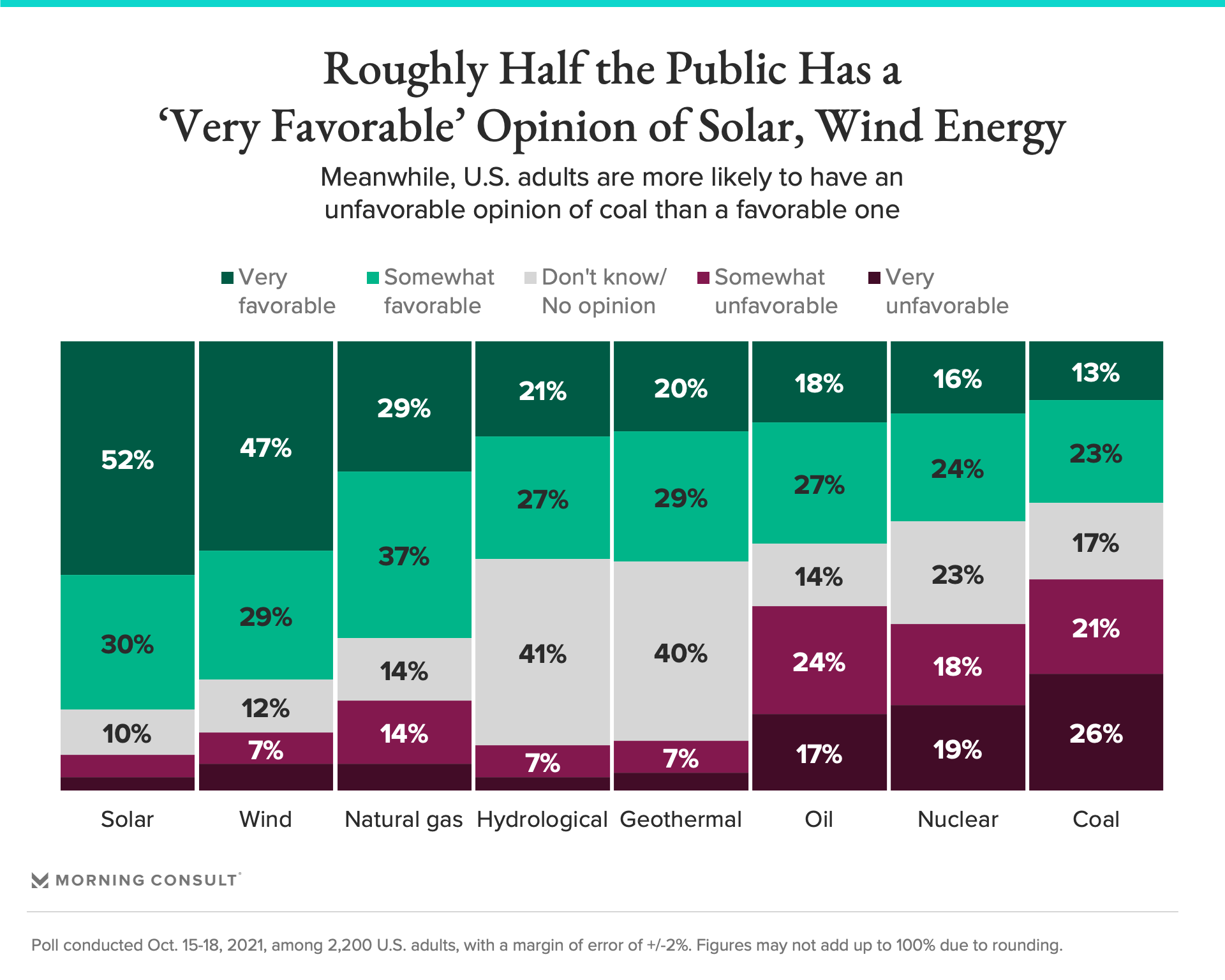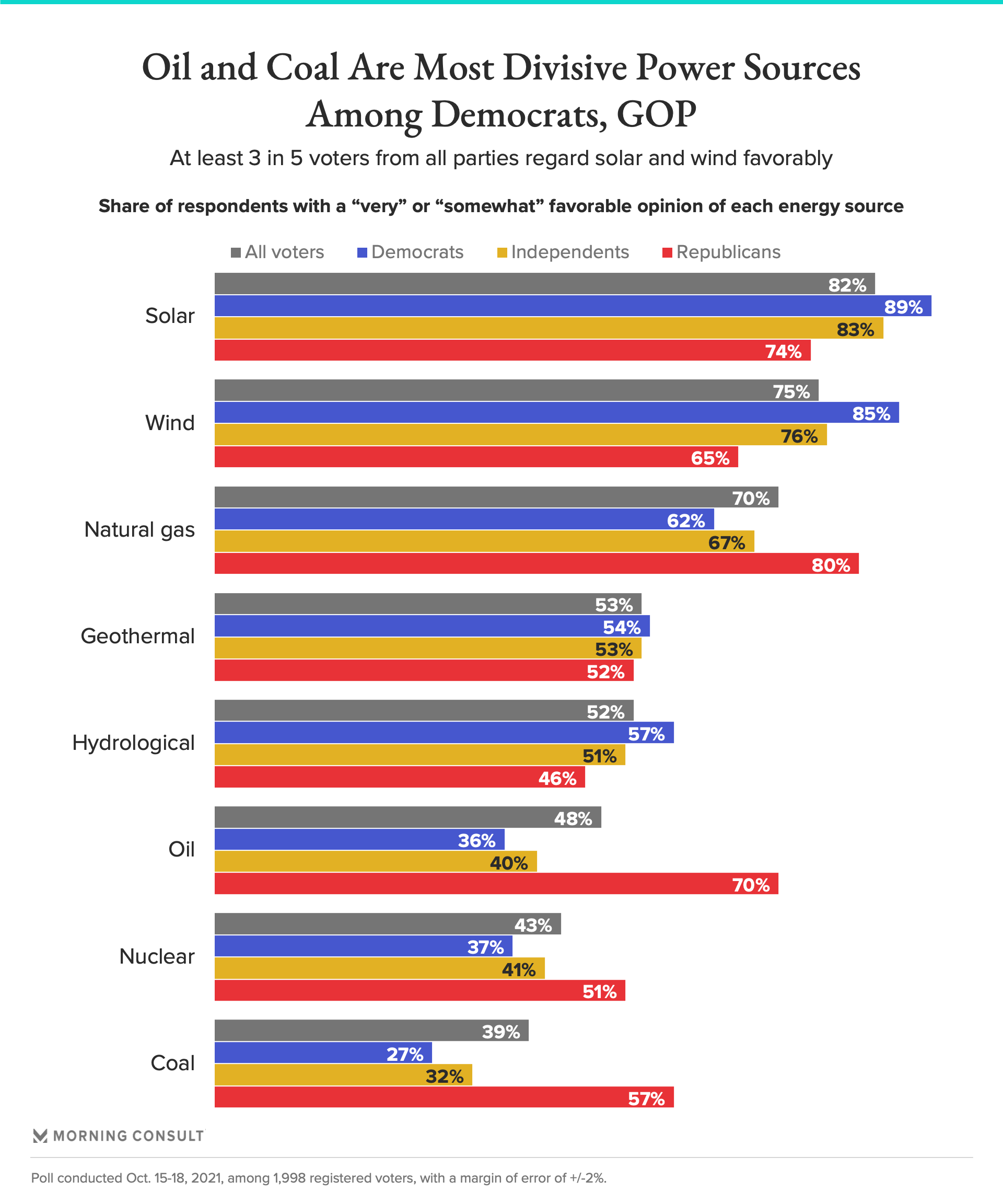Energy
Solar and Wind Are the Public’s Most Favored Energy Sources

TAKING THE TEMPERATURE
This story is part of an ongoing series using data from Morning Consult’s “Taking the Temperature” project, launched in October 2021. It includes regularly updated climate concern and disaster concern trackers, broken down by party, race/ethnicity and generation, as well as a collection of stories based on other trended data on energy sources, fuel and electricity prices and more.
Meeting the Paris Agreement goal of keeping global warming to under 1.5 degrees Celsius above pre-industrial levels requires a concerted transition from one system to another that relies on an entirely different set of energy sources.
As the U.S. delegation to COP26 in Glasgow next week -- and lawmakers at home -- contemplate the specifics of the country’s energy and emissions commitments, the latest data from Morning Consult’s ongoing Taking the Temperature project found that the public has an overwhelmingly positive opinion of zero-emissions sources like solar and wind, with natural gas (a fossil fuel) close behind.
What the numbers say
- As solar’s penetration of the U.S. power system increases, 82 percent of adults have at least a “somewhat favorable” impression of the renewable energy source (with 52 percent reporting a “very favorable” one).
- While oil has higher favorability (45 percent) than nuclear (40 percent), it also has higher unfavorability (41 percent to nuclear’s 37 percent).
- Hydrological and geothermal power had comparable rates of unfavorability to solar, at 10 percent and 11 percent respectively. However, their relative obscurity compared with other energy sources resulted in high shares of respondents saying they didn’t know or had no opinion on either (roughly 40 percent apiece).
What the numbers say, by party
- A large majority of voters have favorable impressions of solar (82 percent) and wind (75 percent), with Democrats more enthusiastic about both than their counterparts across the aisle. But nuclear, which also produces no carbon emissions but tends to be contentious for other reasons, garnered more enthusiasm from Republicans (51 percent) than from Democrats (37 percent).
- Republicans have a more favorable impression of all fossil fuels than Democrats, with a partisan gap of at least 30 percentage points for oil and coal, and a smaller partisan discrepancy for natural gas, which is favored by 70 percent of all voters. Geothermal is the least divisive energy source, with just 2 points separating its favorability among Democrats (54 percent) and among Republicans (52 percent).
The impact
The Biden administration needs as much public support as it can get for its climate and energy policies going into COP26, especially with a narrowly divided Congress and an international community that has historically been difficult to convince of much. So, the overall support for solar and wind -- both of which have featured prominently in the president’s domestic plans -- likely comes as good news to the White House.
However, the preferences of the public do not ultimately have much bearing on the energy sources from which their own corner of the grid draws. Utilities still tend to have near-monopolistic control, which is part of the reason the Clean Electricity Performance Plan became such a contentious climate provision in reconciliation bill discussions. For now, utilities are making emissions pledges of their own, and self-reported industry data shows they are slowly lowering overall emissions rates, even though natural gas still figures prominently in their resource mixes.
The Oct. 15-18, 2021, poll surveyed 2,200 U.S. adults (including 1,998 registered voters) and has a margin of error of 2 percentage points.
Lisa Martine Jenkins previously worked at Morning Consult as a senior reporter covering energy and climate change.
Related content

As Yoon Visits White House, Public Opinion Headwinds Are Swirling at Home

The Salience of Abortion Rights, Which Helped Democrats Mightily in 2022, Has Started to Fade


